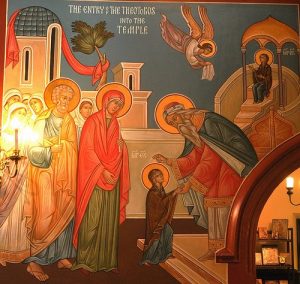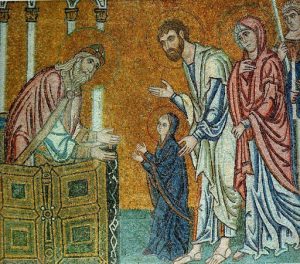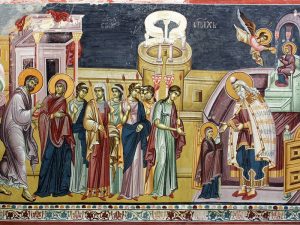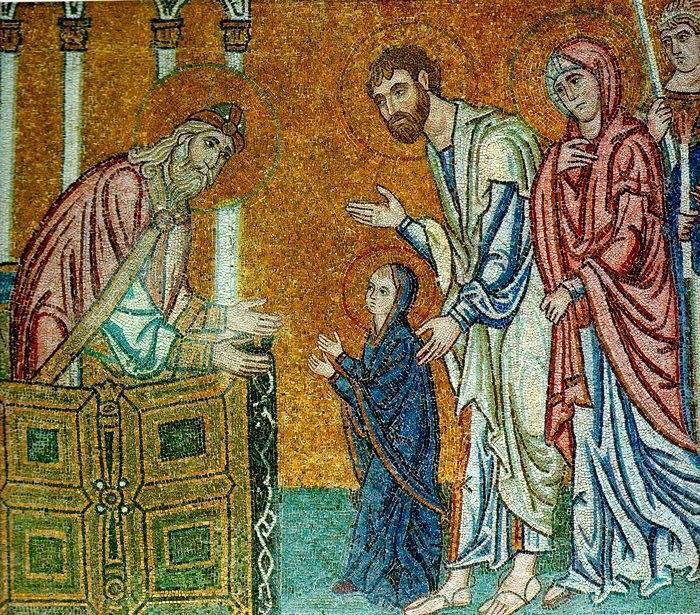 The feast today is the story of our salvation through the temple of God.
The feast today is the story of our salvation through the temple of God.
The first temple was the temple in Jerusalem. It was a foreshadowing of the temple to come. It was localized in one place – the city of Jerusalem. In it were no images of God, for “No one has ever seen God. (1 John 4:12)” The Liturgy tells us that he is “ineffable, inconceivable, invisible, incomprehensible, ever existing, yet ever the same.” The temple was his footstool on earth. Here animal sacrifice was offered to God, which was only a foreshadowing of the perfect sacrifice to be offered by our Lord, “when Christ came as high priest of the good things that have come to be, passing through the greater and more perfect tabernacle not made by hands, that is, not belonging to this creation, he entered once for all into the sanctuary, not with the blood of goats and calves but with his own blood, thus obtaining eternal redemption. (Hebrews 9:11-12)”
The second temple is Mary, the birth-giver of God.” In today’s feast, she enters the temple of Jerusalem in order to replace it, for she shall bear God within her womb. As the new and living temple of God, she is our temple, for like Mary, who carried God in her womb, we receive God into our bodies in Holy Communion. As Mary was fed in the temple by angelic bread, so we receive the bread of life, the Body of Jesus, and his holy blood of the perfect sacrifice, which becomes our sacrifice of praise. St. Paul teaches us, “I urge you therefore, brothers, by the mercies of God, to offer your bodies as a living sacrifice, holy and pleasing to God, your spiritual worship. (Romans 12:1),” in Sunday’s Epistle, he wrote, “you are no longer strangers and sojourners, but you are fellow citizens with the holy ones and members of the household of God, built upon the foundation of the apostles and prophets, with Christ Jesus himself as the capstone. Through him the whole structure is held together and grows into a temple sacred in the Lord; in him you also are being built together into a dwelling place of God in the Spirit. (Ephesians 2:19-22)” This is the temple of God for us today.
The third temple is the one yet to come, but it surpasses all temples, which are only temporary dwelling-places, and so the Book of Revelation foretells, “Then I saw a new heaven and a new earth. The former heaven and the former earth had passed away, and the sea was no more. I also saw the holy city, a new Jerusalem, coming down out of heaven from God, prepared as a bride adorned for her husband. I heard a loud voice from the throne saying, “Behold, God’s dwelling is with the human race. He will dwell with them and they will be his people and God himself will always be with them as their God. He will wipe every tear from their eyes, and there shall be no more death or mourning, wailing or pain, [for] the old order has passed away.” The one who sat on the throne said, “Behold, I make all things new. (Revelation 21:1-5)” This fulfills the first temple of Jerusalem, “(The angel) took me in spirit to a great, high mountain and showed me the holy city Jerusalem coming down out of heaven from God …. I saw no temple in the city, for its temple is the Lord God almighty and the Lamb. The city had no need of sun or moon to shine on it, for the glory of God gave it light, and its lamp was the Lamb. (Revelation 21:22-23)” We pray with St. Paul, “For to me life is Christ, and death is gain. If I go on living in the flesh, that means fruitful labor for me. And I do not know which I shall choose. I am caught between the two. I long to depart this life and be with Christ, for that is far better. Yet that I remain [in] the flesh is more necessary for your benefit. (Phillipians 1:21-24)”
 Tomorrow, November 21, is a holy day. The Divine Liturgy will be served at 9:00 a.m. in both English and Ukrainian.
Tomorrow, November 21, is a holy day. The Divine Liturgy will be served at 9:00 a.m. in both English and Ukrainian. “Seeing the entrance of the pure one, angels marveled in wonder how the Virgin could enter the holy of holies.” (Refrain to Irmos 9, on the feast of the Entrance of the Theotokos into the Temple)
“Seeing the entrance of the pure one, angels marveled in wonder how the Virgin could enter the holy of holies.” (Refrain to Irmos 9, on the feast of the Entrance of the Theotokos into the Temple) And the child was three years old, and Joachim said: Invite the daughters of the Hebrews that are undefiled, and let them take each a lamp, and let them stand with the lamps burning, that the child may not turn back, and her heart be captivated from the temple of the Lord. And they did so until they went up into the temple of the Lord. And the priest received her, and kissed her, and blessed her, saying: The Lord has magnified your name in all generations. In you, on the last of the days, the Lord will manifest His redemption to the sons of Israel. And he set her down upon the third step of the altar, and the Lord God sent grace upon her; and she danced with her feet, and all the house of Israel loved her. And her parents went down marveling, and praising the Lord God, because the child had not turned back. And Mary was in the temple of the Lord as if she were a dove that dwelt there, and she received food from the hand of an angel.”
And the child was three years old, and Joachim said: Invite the daughters of the Hebrews that are undefiled, and let them take each a lamp, and let them stand with the lamps burning, that the child may not turn back, and her heart be captivated from the temple of the Lord. And they did so until they went up into the temple of the Lord. And the priest received her, and kissed her, and blessed her, saying: The Lord has magnified your name in all generations. In you, on the last of the days, the Lord will manifest His redemption to the sons of Israel. And he set her down upon the third step of the altar, and the Lord God sent grace upon her; and she danced with her feet, and all the house of Israel loved her. And her parents went down marveling, and praising the Lord God, because the child had not turned back. And Mary was in the temple of the Lord as if she were a dove that dwelt there, and she received food from the hand of an angel.” The feast today is the story of our salvation through the temple of God.
The feast today is the story of our salvation through the temple of God.